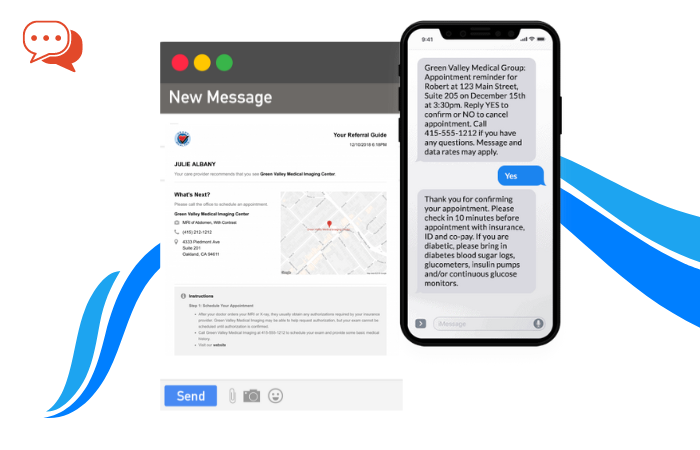It’s hard to deny that circumstances helped make 2020 the year of telemedicine. Even the most technology-reluctant doctors responded to COVID-19 by launching or expanding their telemedicine service lines. Clinical virtual visits fulfilled the necessary social distancing requirements to protect patients and providers. It also added crucial practice revenue at a time when many elective treatments declined.
By mid-year, the predictions suggested virtual healthcare visits will exceed one billion in 2020.
Telemedicine is usually defined as a one-on-one online consultation between a clinical provider and a patient for everything from wellness to COVID-19. However, the technology offers providers several applications to benefit their patients beyond this standard approach, with one of the most exciting being remote patient monitoring.
Consider this your crash course in remote patient monitoring and explain how it can benefit your practice and your patients as the next phase of telehealthcare.

Photo by JESHOOTS.COM on Unsplash
What is Remote Patient Monitoring?
Within the spectrum of telemedicine technology lies remote patient monitoring, which uses audio, video, digital sensors, and the cloud to track patient data after discharge from a healthcare facility. Remote patient monitoring may include:
- Telemonitoring support by phone, secure text, email, or videoconferencing (telemedicine)
- Standalone digital devices that monitor weight, blood pressure, oxygen, or other patient metrics
Typically, remote patient monitoring technologies use digital sensors to transmit patient vital signs over the Internet to the clinical healthcare team. It’s a proactive approach to managing patient care that is immediate, consistent, and perfect for improving the outcomes of long-term chronic illness.
Instead of waiting months for a follow-up visit or forcing patients to travel to a distant clinical site for a routine visit, remote patient monitoring allows doctors to adjust treatments and educate patients on an ongoing basis. This has been shown to reduce the readmission rates and improve patient health outcomes, particularly for the more difficult disorders to maintain, such as chronic diabetes or heart disease.
Remote patient monitoring brings a more holistic, consistent approach to the most complex cases. The technology is often combined with home care visits or outpatient interventions and telephone and video conferencing support. While some hospital readmissions are necessary, for example, a surgical patient may develop an infection, remote monitoring tools for blood pressure, weight, oxygen saturation, and more, combined with video conferencing, can help doctors keep an eye on patients afar. These technologies are connected directly into the patient EHR for better patient care coordination.

Photo by on Pexels
How Widespread is Remote Patient Monitoring?
To date, remote patient monitoring is not a systemic application, but it is growing; and the quick adoption rates of telemedicine are helping. HealthTech reports 88% of healthcare providers have invested in or are considering these technologies to support an increasing influx of chronically ill patients.
There are two primary reasons for the interest in remote patient monitoring. First, the volume of chronically ill patients in our country with one or more diseases has skyrocketed. The National Health Council reported pre-COVID that there were 133 million Americans, or more than 40% of the population, with one ongoing chronic disease. This year, the number was projected to increase to 157 million, although the number could go even higher in light of the pandemic’s lingering effects. Remote patient monitoring is an important tool to provide these patients with ongoing care without the costs associated with travel to a traditional healthcare facility.
Remote patient monitoring is also an important tool to reduce the number of hospital readmissions that place an undue cost burden on the overall system. Many hospital readmissions are avoidable, and hospitals have been given an incentive to improve their efforts to keep patients out of their ERs after initial discharge.
The Affordable Care Act established the Medicare Hospital Readmissions Reduction Program, imposes financial penalties on hospitals with patients returning to the ER within a certain time frame after discharge. Hospital readmissions already tack on $41.3 billion in healthcare costs for patients returning within 30-days of discharge. With these penalties in place, another $564 million in hospital fines were levied against 2,500 hospitals in 2017. However, these costs can be mitigated; the University of Pittsburgh Medical Center used remote patient monitoring to reduce the risks of hospital readmissions by 76%. Even better, the study revealed patient satisfaction scores of more than 90%.
These factors illustrate why the remote patient monitoring market is predicted to reach 2.14 billion annually by 2027. However, the use case for these technologies increased even more when the COVID-19 virus occurred.

Photo by JESHOOTS.COM on Unsplash
How Providers Use Remote Patient Monitoring During COVID-19
For some patients, COVID-19 recovery is a rocky ride. Complications can occur even after patient discharge. Remote patient monitoring allows clinicians to follow patients after they leave the hospital. Having this virtual connection to their clinical care providers can help patients decide if their fever, shortness of breath, or other symptoms are worth the risk of returning to a public healthcare facility.
Noninvasive wearable devices such as a thermometer or a pulse oximeter can gather data long after the patient has gone home. This is particularly important because we’re learning some patients can have long-term heart or lung damage. Science Magazine reports:
“The list of lingering maladies from COVID-19 is longer and more varied than most doctors could have imagined. Ongoing problems include fatigue, a racing heartbeat, shortness of breath, achy joints, foggy thinking, a persistent loss of sense of smell, and damage to the heart, lungs, kidneys, and brain.”
Following the development of persistent lingering health problems with COVID-19 victims is an important and valid use case for remote patient monitoring. Scientists are still struggling to understand the variables of this highly infectious disease. Remote monitoring of patient symptoms after hospital discharge provides the patient with supportive care and provides critical clinical data when we need every advantage we can find over this disease.
Healthcare systems such as UC San Diego Healthcare are trialing remote patient monitoring with COVID-19 patients after their release from the hospital. Some of these patients wear a monitoring device for vital signs such as oxygen saturation and heart rate, sleep quality, and activity levels. These patients use a phone app to complete a daily questionnaire. The information is sent to a HIPAA-compliant dashboard that alerts providers if the patient data shows signs of trouble. Before the rollout of this application, healthcare providers made daily calls to these patients, a laborious, time-consuming manual workflow.
What are the Benefits of Remote Patient Monitoring for Patients and Providers?
Remote patient monitoring, like all telemedicine applications, brings healthcare to the patient in a way that increases access to caregivers. These tools have been particularly effective in rural communities where access to care providers normally requires a long trip to reach a healthcare provider in a more urban setting.
The technology also offers patients and providers a seamless circular communications loop with data flowing from the patient to the clinical team in real-time over the Internet. There are numerous proven benefits of this technology for our nation’s healthcare systems, including:
- Improving visibility into the patient’s health even after the clinical encounter
- Enabling timely intervention to direct the course of a patient’s care
- Improving patient healthcare outcomes by better managing chronic disease
- Decreasing the costs associated with unnecessary ER visits
- Eliminating or decreasing patient readmission penalties
- Increasing patient satisfaction and HCAHPS (the Hospital Consumer Assessment of Healthcare Providers and Systems) scores
- Increasing provider reimbursement
- Improving patient engagement
- Providing more personalized interactive care
- Improving the quality of life for providers and patients
- Improving patient care coordination
- Improving healthcare workflows and streamlining patient care
For patients, the benefits of remote patient monitoring include more convenient and personalized care delivery from their healthcare providers. For rural patients, it’s a lifeline to distant care providers that can save them hundreds of dollars each year in travel costs. Remote care eliminates the inconvenience and cost of traveling to a healthcare facility.
By using remote care monitoring and telemedicine, the hospital discharged patients can receive ongoing education, which can empower them to engage in improved health. COVID-19 also lessens the risk of exposure to the disease. This is particularly important for patients struggling with chronic diseases which are the most vulnerable to the coronavirus.
One goal for remote patient monitoring is to improve the management of chronically ill patients and reduce the cost burden on our nation’s healthcare systems. However, remote patient monitoring’s primary goal and result is a better quality of care and improved health for all Americans.
From managing weight to monitoring blood sugar in diabetes patients or blood pressure for the hypertensive, to routine remote monitoring of incision sites after orthopedic surgery, remote patient monitoring technologies have been designed with the patient’s health in mind. These tools help doctors receive a steady stream of real-time patient data, which allows them to provide feedback on everything from adjusting medication dosages to providing educational support for proactive strategies to improve health.

Photo by Luis Melendez on Unsplash
How Will Remote Patient Monitoring Be Used in the Future?
As a technology application, remote monitoring is just getting started.
However, the positive ramifications for chronic conditions are high. Consider heart failure, the leading cause of hospitalization in Americans over age 65. Close to one-half of hospital readmissions are related to chronic heart failure (CHF) at a cost projected to reach $70 billion by 2030.
Startlingly, many of these costs can be mitigated with remote patient monitoring. CHF patients can be implanted with cardiac monitoring devices that transmit data in real-time to the care provider. Clinicians can promptly review the readings and intervene more quickly to support patient care. One study of an implanted pulmonary artery pressure monitor showed a 33% reduction in hospital readmissions over 18 months. Cardiologists are using remote care technology tools to monitor fluid retention with electronic scales. Other tools monitor the heart’s electrical activity while patients are resting or active to provide a more accurate baseline over a one-time in-office ECG. Pacemakers and implantable cardioverter-defibrillators (ICDs) can now be monitored over the Internet.
Diabetes patients will also benefit in the future from remote monitoring as a standard part of chronic care management. The CDC reports one in 10 Americans (34.2 million) have diabetes and another one in three (88 million) are pre-diabetic. The American Diabetes Association says the annual cost of managing this chronic disease is $327 billion in the U.S. However, a growing body of evidence shows that remote patient monitoring can improve HbA1c for patients living with the disease. Remote patient monitoring tools to transmit self-monitored blood glucose readings to an offsite clinical team. One systematic review of more than 3,000 scientific studies of the application of telemedicine technologies to help these patients found that “telehealth has the potential to deliver beneficial change.” A 2019 study noted, “Patients with more frequent and regular participation in remote monitoring had lower HbA1c levels at the end of the program.”
In April 2020, the FDA expanded the availability of non-invasive remote monitoring devices during the COVID-19 pandemic. The American Diabetes Association partnered with Abbott to donate 25,000 remote care sensors to hospitals worldwide for people living with diabetes. However, this effort is just the beginning of the great potential for remote monitoring in the healthcare space.
Today, physicians can use remote patient monitoring for more than heart disease and diabetes. There are tools available today to help people living with dementia stay in their homes longer or help people with substance abuse disorders receive regular clinical support. Remote monitoring could also help with medication compliance and lifestyle changes in the patient that could improve their health and even lengthen their lives.
There has been enough clinical data collected to know that remote patient monitoring improves healthcare outcomes while reducing the costs of providing care. With all these advantages, it seems clear that providers will continue to increase their use of remote patient monitoring tools. Remote sensor tools are improving, and providers and patients are growing increasingly comfortable with using them. A 2019 study shows two of every three physicians’ plans on using remote patient monitoring tools in the future.
With 2020 marked by first an increase in telemedicine usage and then the normalization of these tools, clinicians, and patients can expect to see increases in remote monitoring in the future. We believe telemedicine is the future. Within this innovative technology lies the cure for many of the detrimental costs and negative treatment outcomes threatening our patients, providers, and the healthcare system as we know it.










